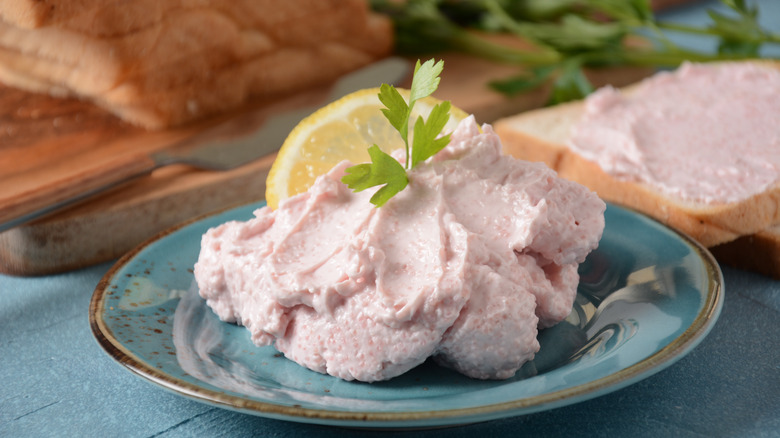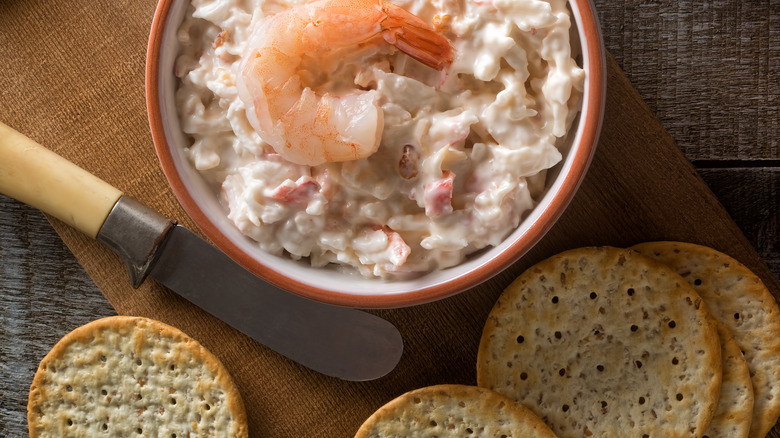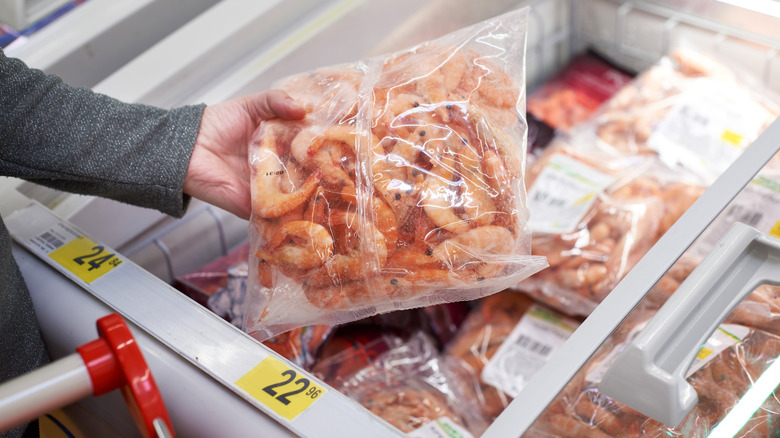Serve Shrimp Butter At Your Next Party And Thank Us Later
For the perfect easy-to-make and scrumptious appetizer to class up your next dinner party, give shrimp butter a try. When it comes to serving seafood appetizers, shrimp cocktail is usually the go-to finger food, but your party guests will be even more impressed with this delicious, creamy shrimp spread. The yummy combination of shrimp and butter are the main components of this mouthwatering hors d'oeuvre, with other commonly used flavor-boosting ingredients like garlic, onion, lemon juice, and Worcestershire sauce, as well as herbs and spices such as black pepper, dill, thyme, and parsley. This tasty shrimp spread is definitely the seafood butter you should always have in the fridge.
Shrimp butter can either be made chunky with larger bits of shrimp mixed in or blended like a puree where the shrimp is visually undetectable, but the buttery, creamy seafood flavor is there. For a smoother consistency, a food processor works great for blending the ingredients. To make it extra creamy, you can also try mixing in some cream cheese and/or mayonnaise. For bonus points on presentation, serve the spread in a dish garnished with parsley, paprika, or lemon wedges. You can also place a couple of whole shrimp on top so your guests know what to expect (also helpful for shellfish allergies).
The best snacks to smear with shrimp butter
You have a few options when it comes to choosing the best snack to spread your shrimp butter on. To balance the creaminess of the butter with a crunchy texture, offer your party guests some saltines or Ritz Crackers alongside the spread. Saltines are salty and airy, with a mild flavor that works well as a vehicle for the shrimp butter, while Ritz Crackers are more buttery and flaky, working equally as well for adding salty, crunchy texture to your bite. Toasted baguettes or crostini, bagel crips, cocktail rye bread, and wheat crackers are also perfect for smearing shrimp butter on. For other ways to incorporate this creamy spread, try mixing it with pasta or layering it between two pieces of bread for a shrimp butter sandwich.
While it's best to serve it immediately and not chilled, you can also refrigerate your shrimp butter for future dinner parties. Just make sure to allow it to reach room temperature before serving so that it's more palatable and easier to bite into. You can also freeze it (for about a month) and thaw it as needed.
Buying shrimp for your spread
If you live near the coast, buying shrimp from a seafood market will yield the freshest, tastiest shrimp, but you can still find good-tasting shrimp at your local grocery store if you know what to look for. A common question people have when buying shrimp is whether to buy it raw or cooked, fresh or frozen, and in the shell or peeled. It's typically recommended to buy frozen shrimp instead of the fresh shrimp you see in the display cases at a grocery store. This is because shrimp is usually frozen immediately after it's caught, so the "fresh" shrimp you see has been thawed and therefore has a shorter shelf-life. Uncooked shrimp in the shell also typically tastes better and won't have the rubbery texture you get with pre-cooked shrimp.
That being said, it's up to you if you'd rather save a step and buy pre-cooked shrimp (figuring that the texture and taste will blend in with the butter and seasonings in the spread). Whether you buy raw or cooked frozen shrimp, it's best to let it thaw in the refrigerator for a day, or, if you need to thaw it quickly, you can place the bag in a bowl of cold water and it should thaw in less than an hour, depending on the size of the shrimp. Make sure to dry the shrimp with a paper towel thoroughly after thawing or cooking to ensure it mixes well into the butter and you're well on your way to a butter spread worth savoring.


